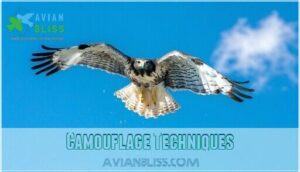This site is supported by our readers. We may earn a commission, at no cost to you, if you purchase through links.
 You’ll spot five key hawks with white bellies across North America that make identification easier than you’d think.
You’ll spot five key hawks with white bellies across North America that make identification easier than you’d think.
The Broad-winged Hawk shows clean white underparts with dark borders, while Red-shouldered Hawks display heavily barred white bellies.
Red-tailed Hawks flash pale undersides with dark belly bands, and Swainson’s Hawks sport distinctive white chests with dark bibs.
The massive Ferruginous Hawk rocks the cleanest white belly of all.
These white undersides aren’t just for show—they’re clever camouflage that helps these raptors blend with bright skies, making them nearly invisible to prey below.
But there’s more to these belly patterns than meets the eye.
Table Of Contents
- Key Takeaways
- Hawks White Belly Types
- White Belly Characteristics
- Hawk Belly Color Development
- Benefits of White Bellies
- Identifying Hawks by Belly
- Frequently Asked Questions (FAQs)
- What bird of prey has a white underbelly?
- Is it rare to see a Cooper’s hawk?
- Is there a white-breasted hawk?
- Does a red-tailed hawk have a white belly?
- Do Hawks have white bellies?
- What are White-tailed Hawks?
- What does a hawk wing look like?
- What does an adult Common Black Hawk look like?
- How can you identify a hawk with a white tail?
- What is a Harris’s hawk?
- Conclusion
Key Takeaways
- You’ll identify five distinct species – Broad-winged Hawks show clean white underparts with dark borders, Red-shouldered Hawks display heavily barred white bellies, Red-tailed Hawks flash pale undersides with dark belly bands, Swainson’s Hawks sport white chests with dark bibs, and Ferruginous Hawks have the cleanest white bellies of all.
- White bellies serve multiple survival functions – They provide sky camouflage, making hawks nearly invisible to prey below, help with temperature regulation by reflecting heat, and can even be used as hunting lures to attract curious prey.
- You can distinguish species by behavioral patterns – Broad-winged Hawks form massive migrating "kettles," Red-shouldered Hawks prefer wooded swamps with distinctive "kee-ah" calls, while Red-tailed Hawks adapt to various habitats, from farmland to urban areas.
- Belly coloration develops through complex processes – White patterns result from reduced melanin production, controlled by genetics, but they are also influenced by molting cycles, sun bleaching, and environmental factors throughout the hawk’s lifetime.
Hawks White Belly Types
You’ll spot five hawk species across North America that showcase stunning white bellies, each with unique field marks that make identification straightforward.
These raptors use their pale undersides for hunting advantages and temperature control, creating some of the most striking silhouettes you’ll see soaring overhead.
Broad-winged Hawk
Typically migrating in spectacular "kettles" of thousands, Broad-winged Hawks showcase distinctive white bellies with brown barring across their underwings.
These medium-sized raptors master hawk identification through their compact build and forest-dwelling habits.
Medium-sized raptors excel at identification through compact builds and forest-dwelling expertise.
Key characteristics for hawks species recognition:
- Flight Patterns – Soar in tight circles during fall hawk migration, forming massive flocks over ridge lines
- Hawk Nesting – Build stick platforms 20-40 feet high in dense deciduous forests near water sources
- Feather Care – Maintain crisp broad wing bands through regular preening, essential for aerodynamic efficiency
Red-shouldered Hawk
You’ll spot Red-shouldered Hawks soaring with their distinctive checkered wing-pattern and rusty-red shoulder patches.
These white breasted hawks prefer wooded swamplands where their piercing "kee-ah" calls echo through cypress trees.
During hawk migration, they’re less nomadic than other hawks species, often staying put year-round in suitable habitat.
| Feature | Description |
|---|---|
| Belly Pattern | White with rusty barring |
| Red Feathers | Bright shoulder patches |
| Hawk Diet | Frogs, snakes, small mammals |
| Feather Care | Fastidious preening routine |
Red-tailed Hawk
You’ll recognize Red-tailed Hawks among hawks with white bellies by their distinctive whitish belly band with scattered dark streaks.
These white bellied hawks master the art of adaptation:
- Red Tail develops after second year molting
- Hawk Diet includes rodents, rabbits, and snakes
- Feather Care maintains pristine white breast plumage
- Nesting Habits favor tall trees near open hunting grounds
- Hawk Migration patterns vary by region and food availability
Their hawks characteristics make white breasted hawks identification straightforward for experienced birders.
Swainson’s Hawk
You’ll spot Swainson’s Hawks during their incredible hawk migration journeys across the Americas.
These white bellied hawks showcase distinctive light-colored undersides with dark flight feathers, making hawks identification easier when they’re soaring overhead.
Their swainson habitat spans grasslands and agricultural areas where they hunt ground squirrels and insects.
Bird conservation efforts track these remarkable travelers as they complete one of nature’s longest hawk behavior patterns, covering up to 14,000 miles annually between breeding and wintering grounds.
Ferruginous Hawk
You’ll easily identify North America’s largest bird of prey by its massive wingspan and distinctive white belly with rusty-red shoulders.
These powerful hawks dominate open grasslands where they hunt ground squirrels and prairie dogs with remarkable precision. The ferruginous hawk’s adaptability to arid environments is a key factor in its survival.
Key Ferruginous Hawk Features:
- Massive size – wingspan reaches 56 inches, making them true giants among hawks habitat dwellers
- Feather colors – adults display rust-colored backs contrasting sharply with white bellied birds undersides
- Nesting habits – build enormous stick nests on cliffs, trees, or ground in Ferruginous Habitat
- Hawk migration – northern populations migrate south while southern birds remain year-round
- Hawks behavior – soar at great heights scanning grasslands for prey, essential for bird conservation efforts
White Belly Characteristics
You’ll notice that a hawk’s white belly isn’t just a random color pattern—it’s actually controlled by melanin pigments, genetic programming, and environmental factors working together.
These characteristics develop through complex biological processes that determine whether you’re looking at a broad-winged hawk’s clean white underside or a red-tailed hawk’s streaky belly band, which is a result of genetic programming.
Melanin Pigments
The melanin pigments in white bellied birds aren’t actually white at all—they’re the absence of color. Hawks with white belly feathers produce less eumelanin in those specific areas, creating striking pigment variation.
This melanin production follows color genetics patterns that determine feather pigmentation during plumage development, giving each bird of prey its unique appearance.
Understanding the role of melanin supplements can provide further insight into the biology of these birds.
Developmental Regulation
During development, you’ll witness Growth Patterns that control how hawk feathers form their distinctive coloration.
Cell Signaling pathways trigger specific Gene Expression sequences, while Hormone Regulation fine-tunes the Morphogenesis process.
White tailed hawks develop their belly patterns through these coordinated mechanisms.
Hawks nesting behaviors don’t influence this process, but hawks diet and overall hawks facts reveal how these systems evolved.
Hawks conservation efforts study these developmental mysteries.
The study of hawk feathers involves understanding feather growth patterns and their role in bird development.
Genetic Factors
Your hawk’s white belly isn’t just pretty plumage—it’s written in their Genetic Code.
Heredity Traits pass down through DNA Analysis, showing specific Gene Expression patterns.
Inheritance Patterns reveal why some hawks facts include consistent white bellies across generations.
White tailed hawks and white headed hawks demonstrate how genetics override environmental factors in hawks nesting sites and hawks diet preferences.
Understanding the hawk’s genetic makeup requires studying genetic code kits, which is crucial for analyzing Heredity Traits and Inheritance Patterns.
Environmental Influences
Climate change is reshaping where you’ll spot white-bellied hawks across North America.
Habitat loss forces these raptors to adapt their traditional territories, while pollution effects alter their food sources.
You’re witnessing ecosystem balance shifts as hawks migration patterns change with warming temperatures.
Conservation efforts now track white headed hawks moving to new regions, making bird watching more unpredictable than ever before.
Understanding how birds adapt to environments through avian adaptation strategies is essential for predicting these environmental changes and requires a deep look into avian adaptation and conservation efforts.
Hawk Belly Color Development
You’ll notice that hawk belly coloration isn’t just about genetics—it’s a dynamic process that changes throughout their lives.
The molting cycle, sun exposure, diet, and even where they live all play roles in developing and maintaining those distinctive white belly patterns you’re trying to identify.
Molting Process
You’ll notice that Feather Replacement happens systematically during Molting Stages, not randomly like you might expect.
Hawks migration timing often coincides with their Plumage Cycle, making bird watching tricky when their Shedding Patterns leave them looking patchy.
Raptors birds replace flight feathers gradually to maintain hunting ability, while bird species show unique molting schedules.
Hawks conservation efforts track these cycles since Flock Behavior changes during vulnerable molting periods when energy demands peak.
Bleaching Effects
Sunlight acts like nature’s bleach on hawk feathers, gradually breaking down melanin pigments that give color.
You’ll notice older hawks with whiter bellies as UV exposure weakens feather structure over time.
This Color Fading process affects raptors birds living in open habitats most severely.
Feather Degradation from Bleach Impact reduces plumage strength, making Hawks Nest conservation efforts essential for these remarkable bird species facing environmental challenges.
Understanding white hawk sightings can provide valuable insights into the effects of leucism on bird populations.
Dietary Influences
What you feed these magnificent birds doesn’t directly change their belly colors, but their dietary choices reveal fascinating patterns.
Hawks with white bellies have evolved specific Hunting Strategies and Prey Selection methods that align with their coloration.
- Prey Selection varies by species – Broad-winged Hawks target amphibians while Red-tailed Hawks hunt mammals
- Food Chains position these raptors as apex predators with specialized Foraging Behavior
- Nutrient Acquisition from diverse prey maintains healthy plumage during molting cycles
- Hunting Strategies often involve soaring above prey, where white bellies provide camouflage against sky
- Wildlife interactions shape feeding patterns across different habitats and seasons
Habitat Factors
Different terrains shape your hawk-watching adventures more than you’d expect.
Open grasslands favor Ferruginous Hawks with stark white bellies, while Forest Edge habitats attract Red-shouldered Hawks displaying checkered patterns.
Woodland Ecology determines nesting sites – dense canopies create shadows that enhance white belly camouflage during hunting.
Migration Routes follow river valleys where terrain features provide thermal updrafts, influencing regional hawk populations and their distinctive belly colorations, including those of Red-shouldered Hawks with white belly camouflage.
Benefits of White Bellies
You’ll discover that white bellies serve multiple survival purposes for these impressive raptors.
These pale undersides help with camouflage, temperature control, hunting success, and species identification in ways that might surprise you.
Camouflage Techniques
Hawks master visual disguise through their white bellies, creating perfect camouflage against bright skies.
You’ll spot these feather patterns working like nature’s defensive secondary – prey can’t detect approaching danger from below.
This color adaptation disrupts their silhouette, making hunting strategies incredibly effective.
Hawks use these concealment methods to blend seamlessly with stadium-bright backgrounds, giving them the ultimate advantage over unsuspecting targets.
Thermoregulation Methods
While camouflage keeps hawks hidden, their white bellies also serve as natural temperature controls.
You’ll discover that Feather Insulation works like a built-in thermostat, helping these birds master Thermal Regulation.
White belly feathers provide:
- Heat Conservation during cold mornings through air pocket trapping
- Cold Adaptation by reflecting excess Solar Radiation away from essential organs
- Enhanced thermoregulation through strategic color placement
- Improved wildlife survival in extreme weather conditions
- Better ecology balance through efficient energy management
Smart birds, these hawks.
Prey Attraction Strategies
You’ll find hawks using their white bellies as fishing lures, literally flashing prey into striking range.
White plumage creates optical illusions that confuse small mammals and birds, making them freeze or move closer to investigate.
These tactics are also related to advanced predator avoidance techniques that enhance survival rates.
| Hunting Tactics | Effectiveness |
|---|---|
| Flash hunting | High success rate |
| Belly exposure | Moderate luring |
| Ground displays | Variable results |
These baiting techniques work because prey mistakes the white flash for food sources or safe spaces.
Hawks master these stealth approaches through practice, turning their camouflage methods into active prey attraction strategies.
Visual Identification
Spotting these raptors becomes second nature once you master their visual signatures.
Hawks display distinctive Hawk Plumage variations, from streaked juvenile patterns to bold adult markings.
Notice the Beak Shapes – hooked bills vary in thickness and curve.
Eye Colors range from bright yellow to deep brown, while Tail Feathers show species-specific banding.
Like finding a Seahawks jersey in a Hawks Nest, proper visual identification separates casual observers from true birding pros.
Identifying Hawks by Belly
You can identify white-bellied hawks by watching their behavior, listening to their calls, and noting where they hang out.
Each species has its own signature moves – like how Broad-winged Hawks form those massive "kettles" during migration, while Red-shouldered Hawks stick to their wooded territories year-round with their distinctive "kee-ah" calls.
Behavioral Characteristics
You’ll notice distinct behavioral patterns that separate white-bellied hawks from other raptors.
Their hunting tactics and flight patterns reveal key identification clues worth mastering.
- Hunting Tactics: Broad-winged hawks prefer stationary perch-hunting, while red-shouldered hawks actively patrol territories
- Flight Patterns: Red-tailed hawks soar with distinctive dihedral wing positioning during thermal riding
- Nesting Habits: Most species build stick platforms in forest canopies, returning to previous sites annually
- Social Behavior: Broad-winged hawks form massive migratory kettles, unlike solitary red-tailed hawk movements
Habitat Association
Hawks’ habitat preferences tell their white-belly story perfectly.
You’ll find Broad-winged Hawks in dense Forest Ecology areas, while Red-shouldered Hawks prefer wooded swamps.
Red-tailed Hawks adapt to fragmented landscapes, using Terrain Features from farmland to urban areas.
Habitat Fragmentation affects Nesting Sites availability, forcing some species into new territories.
Think Hawks Nest stadium views—different angles reveal different species depending on surrounding habitat types.
Migration Patterns
During Fall Migration, white-bellied hawks reveal distinct Seasonal Movements that help with Bird Tracking.
These migration patterns showcase fascinating Habitat Shifts, making wildlife identification easier when you understand their timing and Flock Dynamics.
Researchers study broad winged hawk migration to better understand conservation concerns.
- Broad-winged Hawks form massive "kettles" of thousands during mid-September departures
- Swainson’s Hawks travel over 12,000 miles annually, often fasting for days during migration
- Red-tailed Hawks begin moving in August, with peak activity in mid-October
- Red-shouldered Hawks from northern regions migrate latest, peaking in late October
Vocalization Patterns
Listen closely when you’re out there – hawk calls are like football team chants, each species has its own signature sound.
Red-shouldered hawks scream "kee-ah" repeatedly, while broad-winged hawks whistle soft "pee-oo" notes.
These vocal learning patterns help you identify white-bellied species faster than spotting Seahawks player jerseys from the stands.
Understanding vocal learning mechanisms is essential for identifying and categorizing different hawk species based on their unique vocalization patterns.
Frequently Asked Questions (FAQs)
What bird of prey has a white underbelly?
You’ll spot several raptors flaunting white underparts!
Red-tailed Hawks showcase creamy bellies with dark belly bands, while Red-shouldered Hawks display white chests with rusty barring.
Broad-winged Hawks sport clean white bellies during migration season too.
Is it rare to see a Cooper’s hawk?
Like spotting a neighborhood celebrity, you’ll encounter Cooper’s hawks regularly in suburban areas.
They’re actually quite common across North America, thriving in wooded neighborhoods where they hunt songbirds at backyard feeders.
Is there a white-breasted hawk?
You’re thinking of several species!
White-breasted hawks aren’t one specific bird, but rather multiple hawks sporting pale underparts.
Red-shouldered hawks, broad-winged hawks, and juvenile red-tailed hawks all rock this striking white-belly look perfectly.
Does a red-tailed hawk have a white belly?
Juvenile red-tailed hawks display whitish bellies with scattered dark streaking, while adults typically show darker, more heavily marked undersides.
You’ll notice the distinctive belly band pattern that helps distinguish them from other raptors during identification, which is a key factor in identification.
Do Hawks have white bellies?
Yes, you’ll find several hawk species sporting white bellies.
Red-tailed, red-shouldered, and broad-winged hawks all display white underparts with distinctive markings.
These pale bellies help you distinguish them from darker-bellied raptors during field identification adventures, and the distinctive markings are key to accurate identification.
What are White-tailed Hawks?
White-tailed Hawks (Geranoaetus albicaudatus) are large, powerful raptors you’ll spot in open grasslands and prairies.
They’re basically the cowboys of the hawk world—tough, territorial, and perfectly built for wide-open spaces where they hunt small mammals, making them well-adapted raptors.
What does a hawk wing look like?
Like nature’s flying daggers, hawk wings slice through air with deadly precision.
You’ll spot broad, rounded wings spanning 24-48 inches with distinct feather patterns.
Flight feathers create fingertip-like projections called "fingers" at wingtips, while coverts form overlapping rows above, illustrating the complex structure of a hawk’s wings with deadly precision.
What does an adult Common Black Hawk look like?
You’ll spot an adult Common Black Hawk by its solid charcoal-black plumage, broad rounded wings, and distinctive white tail band.
They’re stocky raptors with yellow legs and bills that love hanging around water sources.
How can you identify a hawk with a white tail?
Tail-watching tactics can reveal identification secrets.
Check for broad white bands across dark tail feathers, especially in Red-tailed Hawks.
You’ll spot distinctive white undertail coverts and barring patterns that separate species during flight, using tail-watching tactics.
What is a Harris’s hawk?
You’ll recognize a Harris’s hawk by its distinctive chocolate-brown plumage with bright rufous shoulders and white-tipped tail.
These social raptors hunt cooperatively in packs, making them unique among North American hawks.
Conclusion
Spotting hawks with white bellies is absolutely mind-blowing once you know what you’re looking for.
You’ve now got the field guide knowledge to distinguish between these five magnificent raptors based on their distinctive belly patterns alone.
Whether you’re watching a Broad-winged Hawk’s clean underparts or admiring a Ferruginous Hawk’s pristine white chest, you’ll never confuse these species again.
Next time you’re outdoors, grab your binoculars and start identifying these incredible birds of prey by their telltale white undersides.
- https://www.birdsoutsidemywindow.org/2018/01/31/who-is-this-white-hawk/
- https://academy.allaboutbirds.org/how-birds-make-colorful-feathers/
- https://www.auburn.edu/cosam/faculty/biology/hill/lab/documents/191.pdf
- https://www.cebc.cnrs.fr/wp-content/uploads/publipdf/2020/AJTB90_2020.pdf
- https://www.hawkmountain.org/raptors/broad-winged-hawk













